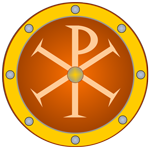
Battle of Rousokastro |
year: 133218 July 1332 |
| A Byzantine defeat by the Bulgarians in the last important battle of the old enemies | ★ ★ ★ ★ ★ |
|
enemy: Bulgarians
|
location: Near the town Rousokastro of SE Bulgaria, 22 km west of Burgas
|
accuracy:
●●●●●
|
|
battle type: Pitched Battle |
war: Later Bulgarian Wars |
modern country:
Bulgaria |
| ▼ The Byzantines(emperor: Andronikos III Palaiologos) | ▼ The Enemies | |
| Commander: | Emperor Andronikos III | Tsar Ivan Alexander |
| Forces: | 3,000 | 11,000 |
| Losses: | 37 cavalry, 300 infantry | slightly more than the Byzantine losses |
| Background story: |
| In 1330, during the short reign (1330-1331) of the Bulgarian Tsar Ivan-Stefan, relations with Bulgaria deteriorated rapidly, mainly because the Byzantines did not help the Bulgarians in their campaign against the Serbs. In 1331, Emperor Andronikos III Palaiologos himself led an army that occupied much of southeastern Bulgaria. The tsar's inability to defend and repel the Byzantine invasion created a crisis in Bulgaria, with the result that the country's lords dethroned Ivan-Stefan and gave the throne to his cousin, Ivan-Alexander.  Ivan Alexander It was at this time that the Bulgarian lord Belaur (or Belauros), uncle of the former tsar Ivan-Stefan, rebelled in Vidin (in the northwestern tip of present-day Bulgaria). This revolt was probably encouraged by the Byzantines. Ivan-Alexander headed to Vidin to quell the uprising, but then Andronikos III invaded from the southeast with an army of 3,000 men, mostly mercenaries (the days when Byzantium had the means to support large armies was a thing of the past). The Tsar had to come back with part of his army, while at the same time asking for reinforcements from the Mongols of the Golden Horde (whose territory in those years had reached north of the Danube, bordering Bulgaria). The Byzantine army marched from Adrianople, recaptured several of the disputed cities, and reached Rousokastro, an old castle that had existed there since at least the 6th century, near the modern town of the same name, 22 km west of Burgas in SE Bulgaria. The Bulgarian tsar also arrived in the area and encamped in the town of Aetos (Айтос), a little further north. |
The Battle: |
 a modern Monument of the battle in the battlefield The two armies were separated by a narrow passage guarded by the Bulgarians. The Byzantine army lined up twice for battle, but the Bulgarians did not respond, not daring to cross the passage and go out into the open. This was a problem for the Byzantines who were not prepared for a long campaign in enemy territory. In the face of the impasse, the two leaders began negotiations in order to reach an agreement. It seems that the difficult subject was Anchialos (today Pomorie in the bay of Burgas) which at that time was in the hands of the Bulgarians. Eventually the Byzantines accepted an agreement according to which they would take back Anchialos and give Diamboli (Yambol - Ямбол). And while everything was ready for the finalization of the agreement, on the night of July 17, the reinforcements that the Bulgarians were waiting for arrived: 3,000 Mongol horsemen. After this development, now having a serious advantage, the Bulgarian Tsar decided to attack. At six o'clock the next morning, his forces came out of the narrow passage and marched against the Byzantines, who hurriedly lined up for battle. On the right side of the Byzantine faction the leader was protostrator Theodoros Synadinos and on the left megas papias Alexios Tzablakon. At the center was the emperor himself. The formation consisted of 16 phalanxes (battalions of 100-150 men) in two rows, 6 phalanxes front and 10 rear. Present also at the center were megas domestikos John Kantakouzenos (the future emperor) and megas primikerios Manuel Asanes as head of an elite unit of 50 knights. Andronikos was very angry about the insidious attack and at first he thought that he was only facing the Bulgarians, until he heard the sound of the Mongol trumpets which had a very characteristic, loud and scary sound. The battle lasted 3 hours. The Mongols, moving independently, managed to overrun the Byzantine formation and attack in the rear from the left, while the Bulgarian infantry attacked from the front, where it was initially repulsed. The 10 phalanxes of the rear row quickly disbanded, but the emperor managed to keep the remaining 6 phalanxes in order and counterattack. But the enemies were much more. After a fierce battle, the Byzantine army began to retreat and at the end the battle was fought under the walls of Rousokastro. Finally the Byzantines could not hold any more and sought refuge inside the castle. At the end of the day, Ivan-Alexander surrounded Rousokastro and sent envoys to Andronikos to resume talks based on what had been agreed the day before. |
Noteworthy: |
| The Mongol allies of the Bulgarians in this battle were deceived by Ivan-Alexander who made them believe that the enemy they would fight was the rebel Belaur and not the Byzantines. |
Aftermath: |
| The Bulgarian Tsar achieved a peace treaty on improved terms. Andronikos was outraged but finally accepted the peace, which was sealed with the marriage of 8-year-old Michael, son of Ivan-Alexander, with Andronikos' daughter, Maria. The victory allowed the Tsar to remain on the throne (for 40 years!). It was the last worth-mentioning battle against the Bulgarians, as the Ottomans prevailed in the region after a few decades. |
|
|
